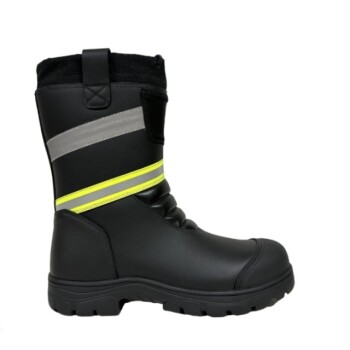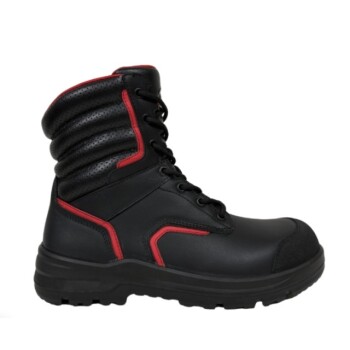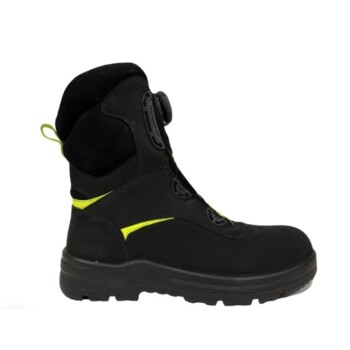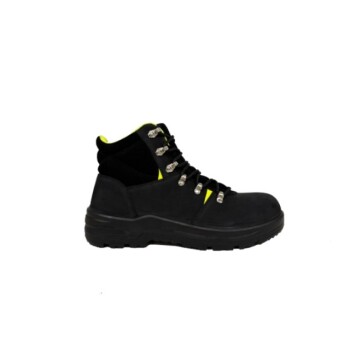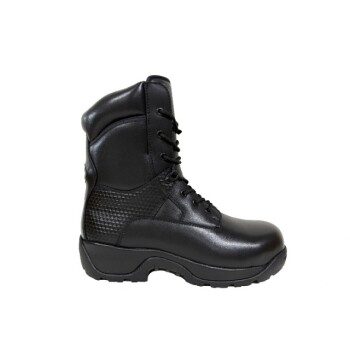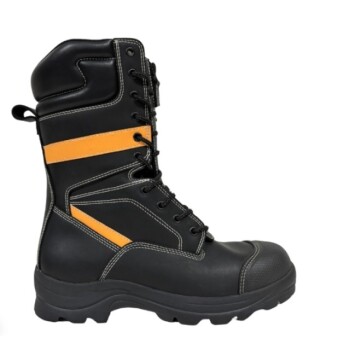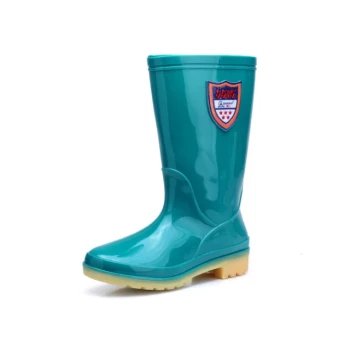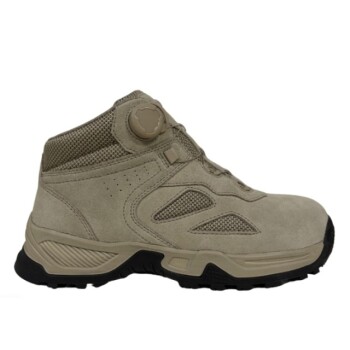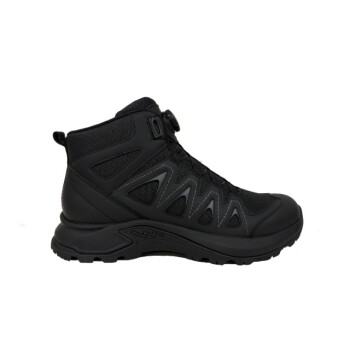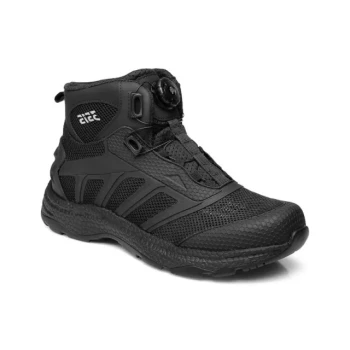Moisture is the primary enemy of warm feet in winter cycling. It makes your feet cold in three distinct ways: it conducts heat directly away from your skin, it causes rapid evaporative cooling as it dries, and it can freeze within your insulation, which accelerates heat loss even further. This moisture comes from both internal sweat and external sources like rain or snow.
Keeping your feet warm is not simply about adding insulation. It is a technical challenge of managing moisture from both inside and out, ensuring proper blood circulation from your core, and minimizing direct heat loss to your bike and the environment.
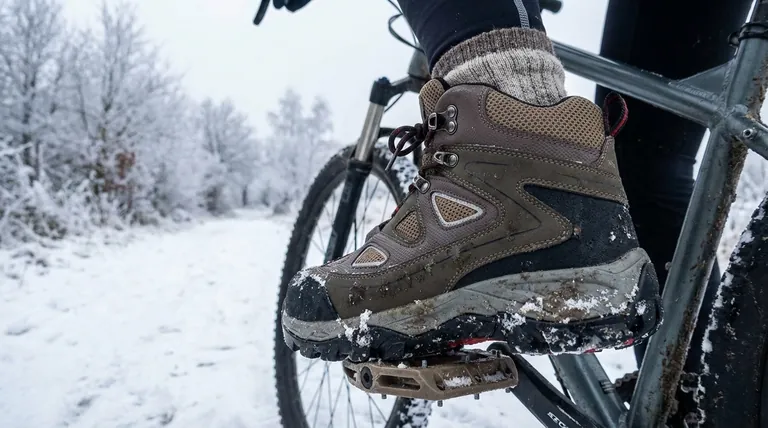
The Three Ways Moisture Chills Your Feet
To effectively combat cold feet, you must first understand the specific physical processes at play. Moisture attacks your warmth through three distinct mechanisms.
Conduction: The Heat Thief
Dry socks and insulation trap air, which is a poor conductor of heat. When this insulation gets wet, water displaces the air. Water is an excellent heat conductor, pulling warmth away from your skin approximately 25 times faster than dry air.
Evaporation: Nature's Air Conditioner
As your body heat causes moisture to evaporate from your socks or skin, it creates a powerful cooling effect. This process, known as phase change, requires energy, and it draws that energy directly from your body in the form of heat. This is beneficial in the summer but disastrous in the winter.
Freezing: The Final Insult
If the temperature drops low enough, the moisture trapped in your socks or shoe insulation can begin to freeze. Ice is also highly conductive, and this frozen layer will continue to drain any remaining warmth from your feet relentlessly.
A Systems Approach to Warmth
Solving the cold feet problem requires looking beyond just your shoes. Warmth is a result of a complete system working together, from your core to your pedals.
It Starts at Your Core
Your body prioritizes keeping your vital organs warm. If your core, hips, or legs get cold, your body will restrict blood flow to your extremities—including your feet—to conserve heat. No amount of foot insulation can overcome poor circulation. Wearing appropriate layers like thermal tights or long johns is a critical first step.
The Footwear System
This is your primary line of defense. A good system includes wool socks, which insulate even when damp, paired with either insulated, winter-specific cycling shoes or standard shoes with insulating shoe covers (booties). Be aware that cycling engages foot muscles less than running, generating less internal heat and making your footwear choice even more critical.
The Bike Interface
Your equipment choices directly impact heat loss. Metal pedals conduct heat away from your feet far more effectively than composite or plastic ones. Furthermore, stiff-soled cycling shoes can restrict the small muscle movements in your feet that generate heat. A slightly more flexible sole can improve circulation and warmth.
Understanding the Trade-offs and Common Pitfalls
Many common solutions for cold feet come with hidden downsides. Being aware of these trade-offs is key to building an effective strategy.
The Waterproofing Paradox
Waterproof boots or socks are excellent at keeping external moisture from snow and rain out. However, they can also be less breathable, trapping sweat inside. This can lead to your socks becoming saturated from the inside out, defeating the purpose. For some riders, Vapor Barrier Liners (VBLs) worn over a thin liner sock can solve this by preventing sweat from ever reaching the primary insulation.
The Compression Problem
A common mistake is to cram the thickest possible socks into your existing shoes. If your footwear becomes too tight, it will constrict blood vessels and restrict circulation, making your feet colder despite the added insulation. It is better to have a slightly less thick sock in a shoe that fits properly.
Ineffective "Hacks"
Some popular DIY solutions are not effective. Placing aluminum foil under your insole, for instance, often shreds quickly and offers minimal insulation. It's better to invest in a quality insulated insole made from wool or closed-cell foam.
Making the Right Choice for Your Ride
Your ideal strategy will depend on the length, intensity, and conditions of your ride.
- If your primary focus is short commutes: Start with insulated, waterproof boots, warm wool socks, and consider insulated insoles to combat heat loss through the pedals.
- If your primary focus is high-intensity training: Prioritize moisture management with a wicking merino wool sock system and well-vented shoe covers to allow sweat to escape.
- If your primary focus is long-distance endurance rides: Consider a dedicated VBL system to keep your main insulation completely dry from sweat over many hours.
- If you struggle with cold feet regardless of footwear: Pay close attention to your core and leg warmth by wearing appropriate thermal tights, as poor circulation is a likely culprit.
Ultimately, achieving warm feet in winter is about actively managing moisture and circulation, not just passively adding bulk.
Summary Table:
| Challenge | Key Insight | Primary Solution |
|---|---|---|
| Moisture Conduction | Water conducts heat 25x faster than air. | Use wool socks that insulate even when damp. |
| Evaporative Cooling | Sweat evaporation pulls heat from your feet. | Ensure proper breathability or use a Vapor Barrier Liner (VBL). |
| Restricted Circulation | Tight footwear reduces blood flow, causing cold feet. | Wear properly fitting shoes, don't overstuff with thick socks. |
| Heat Loss to Bike | Metal pedals and stiff soles conduct heat away. | Use composite pedals and consider insulated insoles. |
Keep Your Customers' Feet Warm with High-Performance Footwear
As a distributor, brand owner, or bulk client, your customers rely on you for gear that performs in all conditions. Don't let cold feet ruin their winter cycling experience.
Partner with 3515, a large-scale manufacturer with the expertise to produce the exact footwear you need. We offer a comprehensive range of cycling shoes, boots, and technical insoles designed for superior moisture management and insulation.
Let us help you build a product line that keeps cyclists comfortable and riding all winter long.
Contact our team today to discuss your manufacturing needs and get a quote.
Visual Guide
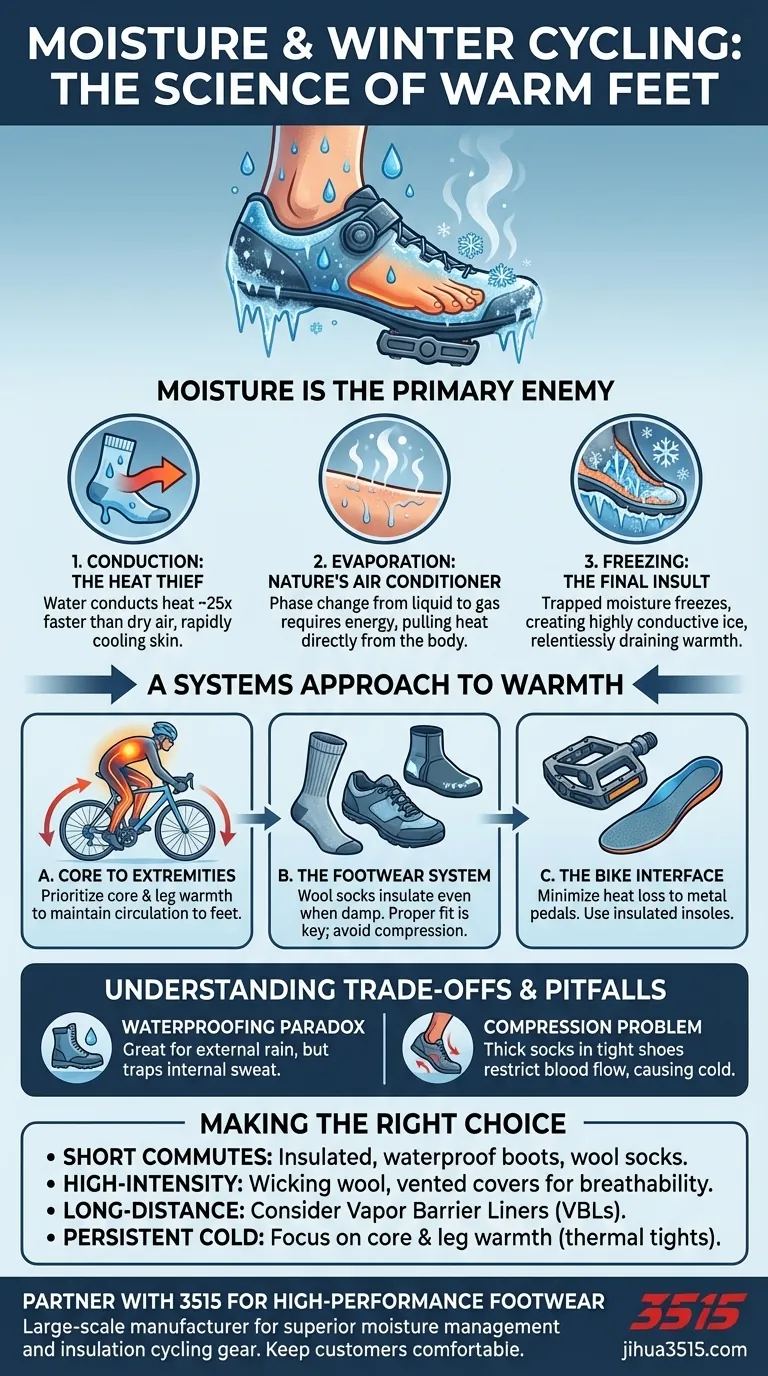
Related Products
- Safety Footwear Wholesale Manufacturer for Custom OEM/ODM Production
- High Performance Fire-Retardant Waterproof Safety Boots
- Factory-Direct Wholesale Canvas Boots with High-Traction Rubber Soles
- Premium Wholesale Waterproof Safety Boots High Performance Protection for Industrial Markets
- Premium High-Cut Waterproof Safety Boots Manufacturing & Wholesale Solutions
People Also Ask
- How long can you wear safety boots? The Lifespan is Determined by Wear, Not Time
- What are the differences between steel toe, composite toe, and alloy toe Wellington boots? Choose the Right Safety Toe for Your Job
- What do heavy duty boots do? Protect Your Feet in Demanding Work Environments
- What are the cultural perspectives on wearing shoes in the house? A Guide to Home Etiquette & Hygiene
- Do snake bite boots work? Your Ultimate Guide to Effective Snake Bite Protection

